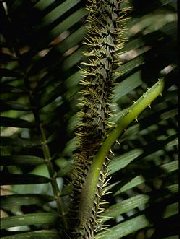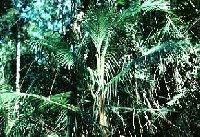Lawyer Cane Plant Use - Ngadjon
Lawyer canes are a feature of the North Queensland rainforests where the Ngadjonji roamed.

Photo - John Wrigley © ANBG
barrga
These climbing palms all belong to the botanical genus Calamus which includes the rattans of South-east Asia, long used for the production of cane furniture.

Photo - John Wrigley © ANBG
jungganyu
In their search for the light of the forest canopy they hitch their way up trees using long barbed tendrils. It is these tendrils, which so easily catch in the clothing of the unwary traveller, that give them their common names of "Lawyer cane" (once they get their hooks into you, they never let go) and "Wait-a-while"
These were particularly important plants for the Ngadjonji, being used for food as well as having a great variety of other uses in their daily lives. The growing tips of young shoots from several species (especially jungganyu)
nigu and yapulam) were a nutritious and tasty food.
Sometimes they were eaten fresh but usually they were cooked in the coals at the edge of a fire.

Photo - Tony Irvine
nigu
The framework for a mija, the weatherproof shelter that the Ngadjonji built in their seasonal camps, was usually constructed from the sturdy but bendable stems of jungganyu. These main frame lengths were tied together using strips of split barrga
Leaves of jungganyu were often used as the final thatching cover of the mija. (See Shelter)

Photo - M.Huxley
yapulam
The distinctive finely-woven two-cornered baskets that were such a feature of Ngadjonji life were woven from barrga, while yapulam was used to make the handles for the baskets. (See Basket Making)
Other important uses of lawyer canes included making traps for eels and other fish, the much-used turkey-traps (jimama), handles for stone axes and the bindings for attaching axe-handles and spear-tips. Paintbrushes, used for applying the coloured ochre patterns to shields and message sticks, were made by teasing apart the fibres at the end of a length of lawyer cane stem.


